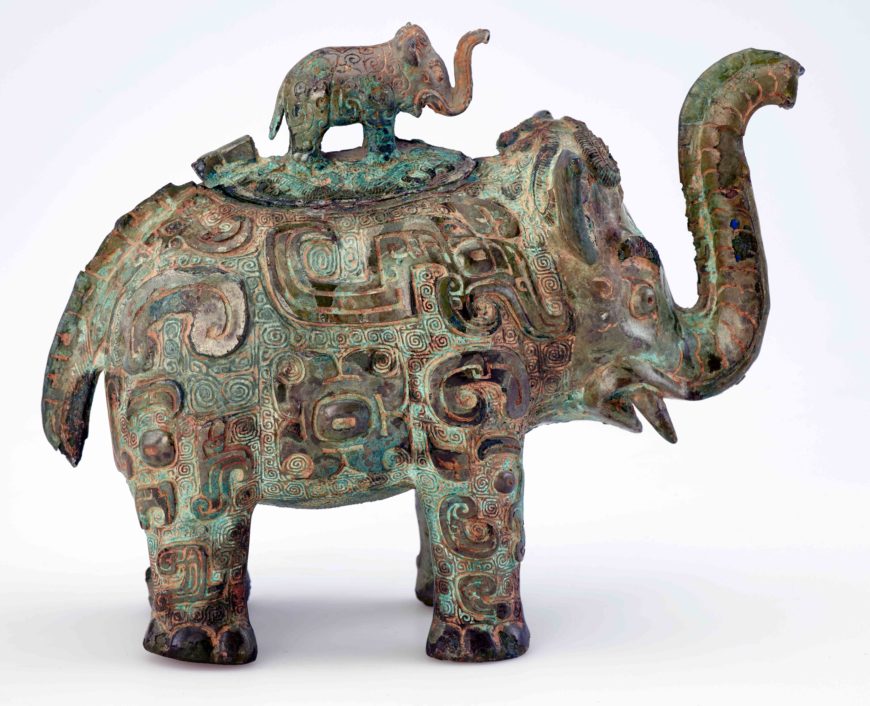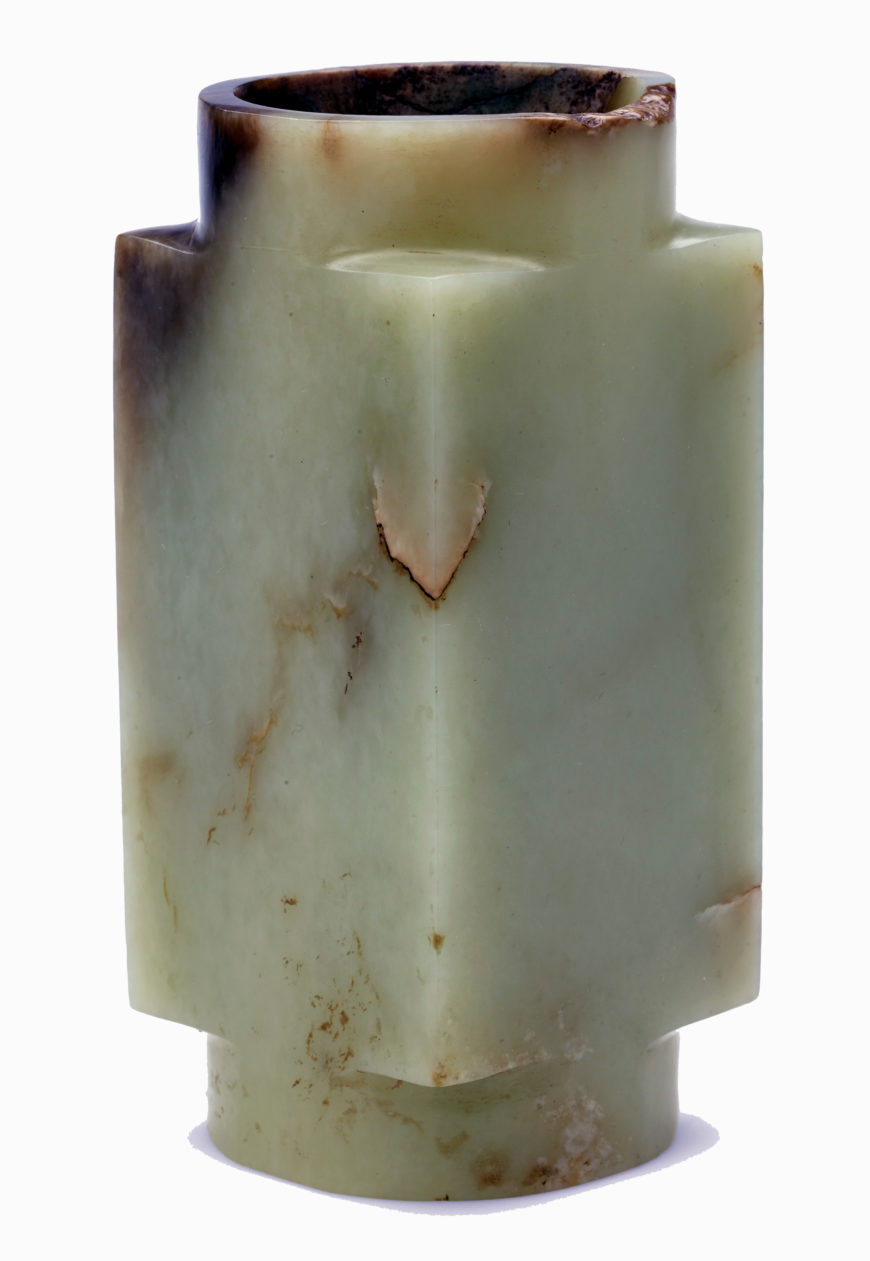
Axe (yue 鉞), Anyang period, late Shang dynasty, c. 1300–1050 B.C.E., bronze with turquoise inlay and jade (nephrite) blade, 21.3 high x 7.9 x 2.1 cm, China, probably Henan province, Anyang (Freer Gallery of Art, Smithsonian institution, Washington, DC: Purchase—Charles Lang Freer Endowment, F1941.4)
The Shang is the earliest dynasty in Chinese history that can be verified through written and archaeological evidence. Established around 1600 B.C.E., it was centered in north China along the Yellow River valley, the so-called cradle of Chinese civilization. This area was ruled by one centralized government—the Shang royal family. The Shang kings ruled the kingdom from the capital city. They moved their capital many times before finally settling near the modern city of Anyang, where they stayed from about 1300 B.C.E. to 1050 B.C.E. The dynasty was ultimately overthrown by the Zhou people. It is clear from archaeological findings that the Shang rulers established a stable social order. Like many other societies, they did so through religion and shared ritual practices.

Inscribed tortoise carapace (“oracle bone”), Anyang period, late Shang dynasty, c. 1300–1050 B.C.E., tortoise shell, China, 6.5 high x 10.8 x 2.3 cm (Arthur M. Sackler Gallery, Smithsonian Institution, Washington, D.C.: The Dr. Paul Singer Collection of Chinese Art of the Arthur M. Sackler Gallery, Smithsonian Institution; a joint gift of the Arthur M. Sackler Foundation, Paul Singer, the AMS Foundation for the Arts, Sciences, and Humanities, and the Children of Arthur M. Sackler, S2012.9.445)
The Shang people centered their religious belief in a supreme deity, Di (Dee), who controlled the known universe. He also ruled over other spirits, including nature spirits and the ancestral spirits. The king was the only one who could communicate with Di. He did so by appealing to the royal ancestors, who were believed to be intermediaries between the king and Di. Performing divinations was one way to communicate. The king used “oracle bones”—tortoiseshells and ox scapulae—in elaborate divination ceremonies. The questions for the ancestors ranged from the weather to the outcome of a battle to the selection of heir for the throne. Afterward, both the questions and answers were frequently carved onto the object used in the ritual. These inscriptions mark the beginning of Chinese written history.

Lidded ritual ewer (huo) in the form of an elephant with masks and dragons, ca. first half 11th century B.C.E., bronze, 17.2 high x 10.7 x 21.4 cm, China, Middle Yangzi Valley (Freer Gallery of Art, Smithsonian Institution, Washington, DC: Purchase — Charles Lang Freer Endowment, F1936.6a-b)
The king would also make frequent sacrifices to ancestors to ensure their happiness so that they would continue to protect and bless his family and people. This began the enduring tradition of ancestor worship in Chinese culture. Bronze vessels played a critical role in these religious rituals. They were used to present offerings of wine and food to ancestral spirits. Wine vessels were particularly important for the Shang people, considering the number and variety of wine vessels discovered in Shang tombs. Some of the bronze vessels bear short inscriptions, usually two or three characters long, referring to a clan name and deceased ancestor. The Shang people’s love for animal designs is demonstrated by the common motifs used for Shang ritual bronzes, which included taotie masks, dragons, birds, and other geometric patterns. Besides vessels, bronze was used to make weapons for warfare. Together with chariots that had bronze fittings, these weapons equipped the Shang military force and allowed the Shang to maintain its military supremacy. However, the primary function for bronze was probably to make tools that increased the efficiency of agriculture and food production.

Tube (cong 琮), Anyang period, probably late Shang dynasty, c. 1300–1050 B.C.E., jade (nephrite), China, probably Henan province, Anyang, 16.6 high × 7.1 × 7.1 cm (Arthur M. Sackler Gallery, Smithsonian Institution, Washington, DC: Gift of Arthur M. Sackler, S1987.466)
Jade continued to be highly prized during the Shang dynasty. Some types of jade objects first created in the Neolithic period (c. 7000–1700 B.C.E.), such as the bi and cong, were still produced for ceremonial purposes. Since bronze was acquiring new importance as the material for conducting rituals, however, jade was more commonly used for personal ornaments.
The Shang people left many legacies for later generations: They established the political system and dynastic succession that lasted thousands of years. The tradition of ancestor worship is still key to Chinese culture today. Finally, the artistry and workmanship of Shang bronzes and jades continue to be admired to this day.
This resource was developed for Teaching China with the Smithsonian, made possible by the generous support of the Freeman Foundation



